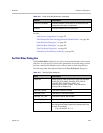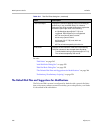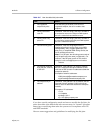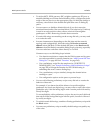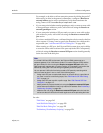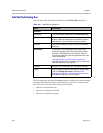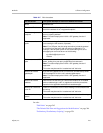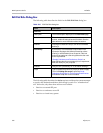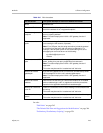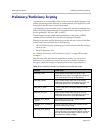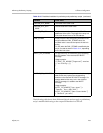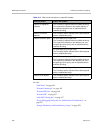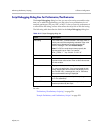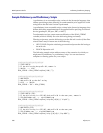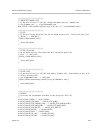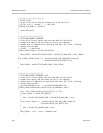
Dial Rules Call Server Configuration
Polycom, Inc. 253
See also:
“Dial Rules” on page 243
“The Default Dial Plan and Suggestions for Modifications” on page 246
“Preliminary/Postliminary Scripting” on page 254
Table 10-9 Dial rule actions
For this action: The system attempts to resolve the address as follows:
Block Blocks the call.
Resolve to IP address Tries to treat the dial string as an IP address, and if it can, assumes
that it’s the address of an unregistered endpoint.
Resolve to registered
endpoint
Looks for a registered endpoint (active or inactive) that has the same
alias or signaling address.
Note: This action employs the H.323<->SIP gateway function if
applicable.
Resolve to service
prefix
Looks for a service prefix that matches the beginning of the dial string
(not counting the URI scheme, if present).
Note: For a SIP peer, the dial string must either include the protocol
or consist of only the prefix and user name (no @domain). For
instance, if the SIP peer’s prefix is 123, the dial string for a call to
alice@polycom.com must be one of the following:
sip:123alice@polycom.com
123alice
Resolve to external SIP
peer
Checks the domain of the dial string against all of the rule’s selected
peers, looking for a peer proxy responsible for that domain.
Note: This action employs the H.323<->SIP gateway function if
applicable.
This action may be used for “unauthorized call” dial rules.
Resolve to external
gatekeeper
If the dial string appears to be an H.323 alias, simultaneously sends
LRQ messages to all of the rule’s selected gatekeepers.
Note: This action employs the H.323<->SIP gateway function if
applicable.
Resolve to external
address
Determines if the dial string is a well-formed instance of an enabled
external address type, and if so, applies the resolution procedures
specified in the applicable standard for that address type.
Resolve to conference
room ID
Looks for a conference room or virtual meeting room that matches the
dial string.
This action may be used for “unauthorized call” dial rules.
Resolve to virtual entry
queue
Looks for a shared-number entry queue that matches the dial string.
This action may be used for “unauthorized call” dial rules.



